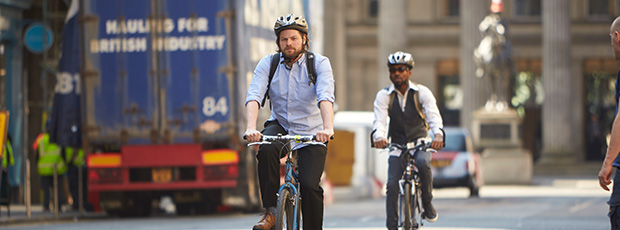The population health, environmental, and wider economic benefits of cycling are well evidenced. However, perception of risk is a major barrier to people travelling by bike. This new research emphasises the importance of quality cycling infrastructure and increased capacity for reporting and investigation of cycling casualties to really understand risk, behaviour change and trends.
Fewer cycling casualties involve children
The research also reveals that far fewer children were casualties in 2018 compared with 1995. Cycling casualties were highest among young to middle aged adults (65% of all casualties in the last five years were aged 25-54 years) which is broadly representative of the age groups most likely to cycle. Most casualties (82%) were male, highlighting the cycling gender divide, where in the UK men are three times more likely to cycle than women.
1-in-10 are hit and runs
The majority (85%) of collisions resulting in a cycling casualty involved a car and 1-in-10 reported casualties were hit and run incidents. Near misses occur far more frequently than actual collisions and are significantly associated with an increased perception of risk when cycling. There were small but notable increases in cycling casualties at roundabouts, the pedestrian phase of traffic signal junctions, and where vehicles were turning right.
Pedestrian injuries caused by a collision with a cyclist were rare, and there is no evidence that e-bikes are more likely to be involved in a crash compared to a pedal bike.
 The research looked at reported cycling casualties in Scotland over a 23-year period (1995-2018) alongside a review of under-reporting and near misses. Although this is the most up-to-date detailed study of cycling casualties and near misses in Scotland, the report also highlights issues with data quality and completeness.
The research looked at reported cycling casualties in Scotland over a 23-year period (1995-2018) alongside a review of under-reporting and near misses. Although this is the most up-to-date detailed study of cycling casualties and near misses in Scotland, the report also highlights issues with data quality and completeness.
Most incidents are unreported
Reported cycling casualties with slight and serious injuries are underestimated by half, and near misses are a daily experience for people cycling but considerably under-reported. This report has not determined the exposure (level of risk to an individual) associated with cycling due to this under-reporting of casualties and a shortage of data on who is cycling and how far. While there is limited data on cycling trends in Scotland, the UK Department of Transport estimates there has been a 27% rise in distances cycled on Scotland’s roads since 1993. Other evidence suggests that cycling levels in our largest cities, Glasgow and Edinburgh, have risen in the last 10 years.
This points to an urgent need for more accurate and complete reporting of cycling casualties and more detailed monitoring of who cycles in order to really understand risk, behaviour change and trends. This is crucial given that perception of risk plays a big part in cycling uptake among the population.
Need for improved infrastructure
The research emphasises the importance of continuing to build on the strong commitment to active travel in Scotland and calls for substantial and sustained government investment to deliver infrastructure in line with European countries with high levels of cycling. The need to significantly increase sustainable active travel as part of meeting Scotland’s 2045 net-zero emission target is clear. Cycling is integral to achieving this, and safety for people cycling therefore requires a high level of attention. This includes lower road speeds, a comprehensive network of dedicated cycling routes, and increasing levels of police enforcement and investigation of cycling casualties and all road traffic crashes.
Reflecting on the findings, Dr Mairi Young, Public Health Research Specialist at the GCPH and co-author of the report commented: “Scotland has an ambitious target of net-zero emissions of all greenhouse gases by 2045. In order to achieve this target, we need to move away from cars being the default mode of transport to more sustainable modes of transport, such as cycling. Infrastructure investment alone is not enough for a complete modal shift from car to bike but is a necessary condition. Road sharing, as seen in the UK, is shown to result in increased (real and perceived) risk for cyclists. An integrated transport system where a bike can take you from door to door, and a comprehensive cycling network separated from motor traffic can reduce the risk of injury and improve cycling uptake.”
Commenting on the wider relevance of findings, Bruce Whyte, Public Health Programme Manager at the GCPH and co-author of the report added: “The population health, environmental, and wider economic benefits of cycling are well known. To increase levels of cycling in Scotland, we need to make cycling safe, affordable and accessible for all. Investment in cycling needs to be sensitive to existing inequalities and we need to ensure safe cycling infrastructure (including bike hire schemes) is equally available across our communities, support bike inclusion schemes (such as Bikes for All) and reduce road speeds, particularly in urban settings.”
Evidence, education and enforcement
Chief Executive of Cycling Scotland, Keith Irving, stated: “Significant progress has been made to reduce road casualties in Scotland in the last ten years but it’s clear that more action is needed, especially on reducing cycling casualties. Together with infrastructure, education and enforcement, improving the evidence about cycling casualties, including the exposure to risk and under-reporting of serious injuries is key to prevention, as our research highlights. The new Road Safety Framework to 2030 is a welcome opportunity to ensure a robust, evidence-based approach.
Cycling is fantastic for your health and the chance of serious injury is, thankfully, low, yet the perception of risk is understandably high and fear of road traffic is the number one barrier to cycling. We need to ensure our roads are safe for people cycling.”